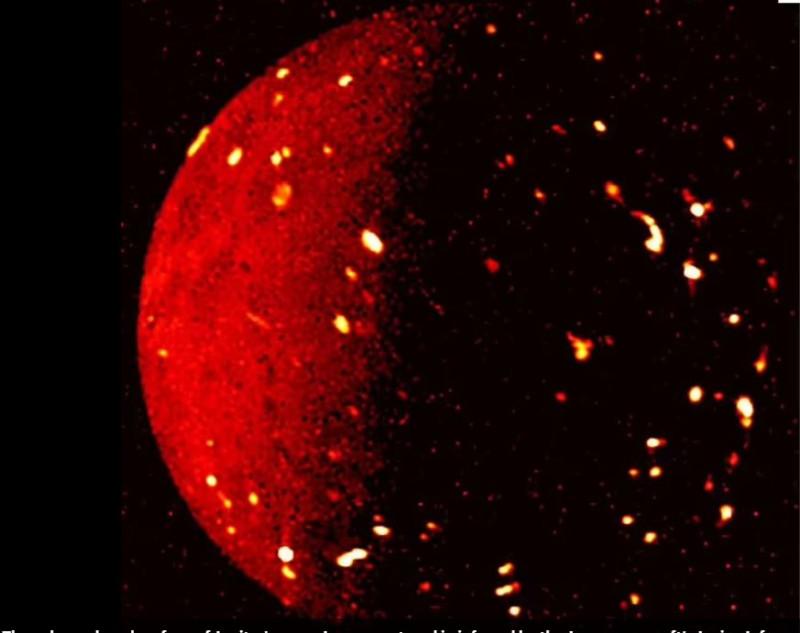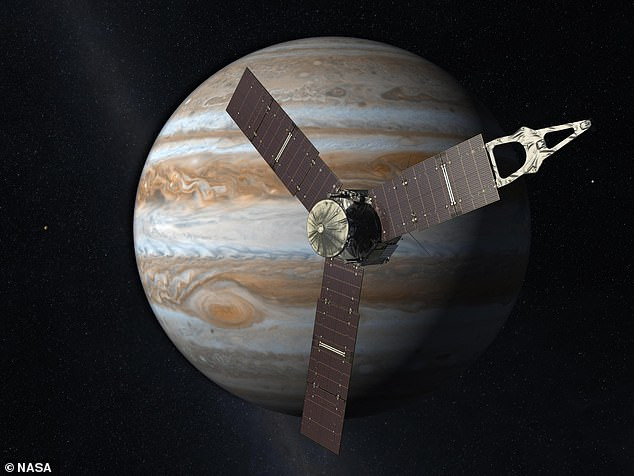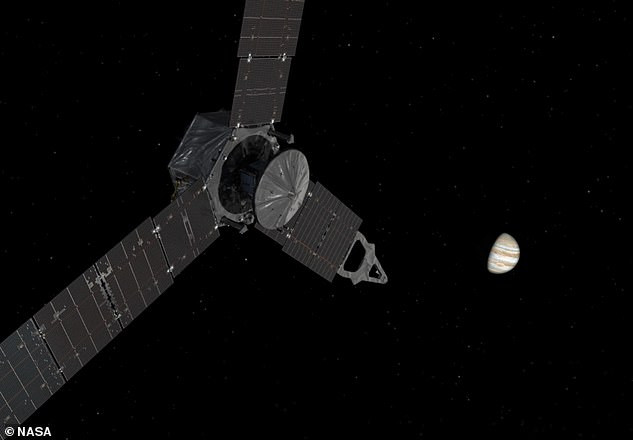Juno arrived at Jupiter in 2016 after a five-year journey and will continue to survey the gas giant and its moons until 2025
NASA has released a stunning photo of Jupiter’s moon Io, showing fiery lava lakes glowing brightly on its surface.
The image, taken in July but released by NASA this week, was taken by the Juno spacecraft’s Jovian Infrared Auroral Mapper (JIRAM) imager.
It shows several of Ios’ volcanoes as glowing lights, some of which are erupting lava fountains tens of miles high.
NASA said Juno took another set of images of Io on Thursday (Dec. 15), which will be released soon.
Juno arrived at Jupiter in 2016 after a five-year journey and will continue to survey the planet and its moons until 2025.
The spacecraft is now in the second year of its extended mission to explore Jupiter’s interior.
It was scheduled to end in February 2018 after completing 37 orbits of Jupiter, but got an extension to 2025 to make another 42 orbits.
“The team is really excited that Juno’s extended mission includes studying Jupiter’s moons,” said Juno principal investigator Scott Bolton of the Southwest Research Institute in San Antonio.
“The Juno sensors are designed to study Jupiter, but we’re excited about how well they can do double duty by observing the planet’s moons.”
The image of Jupiter’s volcanic surface was captured in infrared by JIRAM as Juno flew by at a distance of about 50,000 miles (80,000 km) on July 5, 2022.
The brightest spots in the image – which look like a string of Christmas lights – indicate the hottest temperatures.
Io is described by NASA as “the most volcanic place in the solar system”, with hundreds of volcanoes erupting from lava fountains.
The moon even has lakes of molten silicate lava — molten mixtures dominated by oxygen and silicon — on its surface.
In the new shot, Io appears red due to the infrared light captured by JIRAM, but the best approximation of what it would look like to the human eye shows a mostly yellowish sphere, speckled with green and black blemishes.
Io will remain the focus of the Juno team for the next year and a half.
Juno’s exploration on Dec. 15 marked the first of nine flybys — two of them from just 930 miles (1,500 kilometers) away. NASA says: “Juno scientists will use these flybys to conduct the first high-resolution monitoring campaign on the magma-coated moon, studying the volcanoes of Ius and how volcanic eruptions interact with Jupiter’s powerful magnetosphere and aurora.” .
Juno arrived at Jupiter on July 4, 2016, after launching from Cape Canaveral Air Force Station on August 5, 2011.
Juno has three giant blades that extend about 66 feet (20 meters) from its cylindrical, six-sided body.
It made a close flyby of Ganymede in June 2021 and of Europa in September of this year.
Images of Ganymede’s flyby were captured as it passed within 645 miles (1,038 kilometers) of the icy moon.
The last time a spacecraft came this close to Ganymede was in May 2000, with NASA’s Galileo spacecraft.
Likewise, Juno gave us the closest look at Europa that any spacecraft has offered in more than 20 years, when Galileo came within 218 miles (351 km) of the surface in January 2000.
Juno captured Europa’s ice-covered surface in exquisite detail when it came within 219 miles (352 km) of its surface on September 29. An interactive NASA tool provides real-time updates of Juno’s location relative to Jupiter and its moons.
Read the News today and get the latest news.
Follow Skai.gr on Google News and be the first to know all the news.
I am Terrance Carlson, author at News Bulletin 247. I mostly cover technology news and I have been working in this field for a long time. I have a lot of experience and I am highly knowledgeable in this area. I am a very reliable source of information and I always make sure to provide accurate news to my readers.













